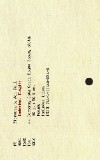
Indexical Elegies
Jon Paul Fiorentino
Coach House Books
$16.95
paper
80pp
978-1-552452-34-9
philosophical systems because he kept finding flaws in his own thought. Wittgenstein only did this once.) Peirce’s theory of signs is useful for a poet: he saw reality as a texture of socially-created signs, which he classified as icons, indices, and symbols. It is the
index that fascinates Fiorentino. Icons (roughly speaking, meta phors) and symbols need not have links to real things, but the index does.
The core of Indexical Elegies is a set of poems lamenting Robert Allen, the beloved Montreal poet and editor, also memorialized in
Jason Camlot’s The Debaucher(mRb Fall/Winter 2008). Fiorentino is not interested in the conventions of the pastoral elegy – shepherds, symbolic flowers, and mythical allusions – for, as he says, “icons bore us to death,” an interesting play on words for an elegist. The work resists turning Allen into a symbol; Fiorentino wants to point to a real person and a real loss. But simply stating a loss is not enough: grief should not be inarticulate. In place of mythology and conventional symbols, the poems explore the nature of language through puns, onomatopoeia, and aphorisms about meaning. This playful but serious deployment of signs is appropriate to commemorate a writer as postmodern and seriously playful as Allen. Of course, the elegist is a survivor of the person commemorated: the paradoxical craving is to keep the object of grief present, which intensifies the sense of loss. Appropriately, then, one of the epigraphs to these elegies comes from Peirce: “the index is physically connected with its object; they make an organic pair.” Fiorentino’s poetic structures are suited to epigrams and oracular sayings: he likes couplets, triplets, and quatrains, and he delights in antithesis. His combination of feeling and thought gives this book remarkable power. mRb






0 Comments